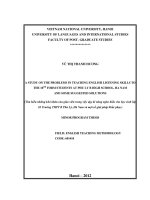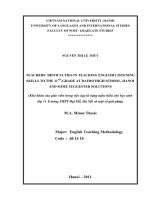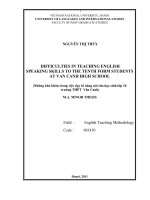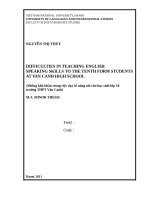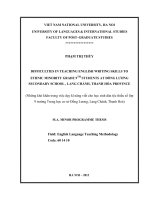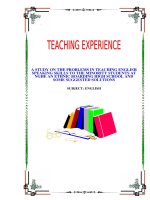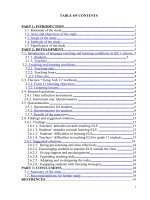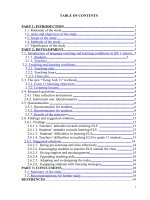Teachers' difficulties in teaching English listening skills to the 11th -grade at Daimo High school, Hanoi and some suggested solutions = Khó khăn của giáo viên
Bạn đang xem bản rút gọn của tài liệu. Xem và tải ngay bản đầy đủ của tài liệu tại đây (1.72 MB, 61 trang )
VIETNAM NATIONAL UNIVERSITY, HANOI
UNIVERSITY OF LANGUAGES AND INTERNATIONAL STUDIES
FACULTY OF POST- GRADUATE STUDIES
**************
NGUYỄN THỊ LỆ THỦY
TEACHERS’ DIFFICULTIES IN TEACHING ENGLISH LISTENING
SKILLS TO THE 11
TH
-GRADE AT DAIMO HIGH SCHOOL, HANOI
AND SOME SUGGESTED SOLUTIONS
(Khó khăn của giáo viên trong việc dạy kĩ năng nghe hiểu cho học sinh
lớp 11 Trường THPT Đại Mỗ, Hà Nội và một số giải pháp)
M.A. Minor Thesis
Major: English Teaching Methodology
Code : 60 14 10
Hanoi – 2011
VIETNAM NATIONAL UNIVERSITY, HANOI
UNIVERSITY OF LANGUAGES AND INTERNATIONAL STUDIES
FACULTY OF POST- GRADUATE STUDIES
**************
NGUYỄN THỊ LỆ THỦY
TEACHERS’ DIFFICULTIES IN TEACHING ENGLISH LISTENING
SKILLS TO THE 11
TH
-GRADE AT DAIMO HIGH SCHOOL, HANOI
AND SOME SUGGESTED SOLUTIONS
(Khó khăn của giáo viên trong việc dạy kĩ năng nghe hiểu cho học
sinh lớp 11 Trường THPT Đại Mỗ, Hà Nội và một số giải pháp)
M.A. Minor Thesis
Major: English Teaching Methodology
Code : 60 14 10
Supervisor: CHU THỊ PHƯƠNG VÂN M.A.
Hanoi - 2011
iv
TABLE OF CONTENTS
Declaration i
Acknowledgements ii
Abstract iii
Table of contents iv
List of abbreviations viii
List of tables and charts viii
PART I: INTRODUCTION 1
1. Rationale of the study 1
2. Aims and objectives of the study 1
3. Scope of the study 2
4. Methods of the study 2
5. Significance of the study 2
6. Design of the study 3
PART II: DEVELOPMENT 4
CHAPTER 1: LITERATURE REVIEW 4
1.1. Definitions of listening 4
1.2. Communicative approaches to listening comprehension 5
1.3. Stages of a listening lesson 7
1.3.1. Pre-listening stage 7
1.3.2. While-listening stage 8
1.3.3. Post-listening stage 9
v
1.4. The teacher’s role in the listening lesson 10
1.5. Potential problems in learning ELS 12
1.6. Strategies of listening comprehension 13
1.7. Role of motivation, interest and relevance in learning ELS 14
CHAPTER 2: RESEARCH METHODOLOGY 16
2.1. Introduction of language teaching and learning conditions in DM school 16
2.1.1. Subjective factors_Human 16
2.1.1.1. The learners_ Grade 11
th
students 16
2.1.1.2. The teachers 16
2.1.2. Objective factors_Teaching and learning conditions 17
2.1.2.1. Teaching aids 17
2.1.2.2. Duration 17
2.1.2.3. Class size 17
2.2. The new “Tieng Anh 11” textbook 17
2.2.1. Grade 11 listening objects 18
2.2.2. Listening lessons 18
2.3. Research questions 18
2.4. Data collection instruments 19
2.4.1. Instrument one: Questionnaires 19
2.4.2. Instrument two: Interviews 19
2.5. Summary 20
CHAPTER 3: DATA ANALYSIS AND DISCUSSIONS 21
3.1. Questionnaires 21
vi
3.1.1. Questionnaires for students 21
3.1.2. Questionnaires for teachers 28
3.2. Results of the interviews 34
3.3. Summary 37
CHAPTER 4: FINDINGS AND SUGGESTED SOLUSIONS 38
4.1. Findings 38
4.1.1. Teachers’ attitudes towards teaching ELS 38
4.1.2. Students’ attitudes towards learning ELS 38
4.1.3. Students’ difficulties in learning ELS 39
4.1.4. Teachers’ difficulties in teaching ELS to grade 11 students 39
4.2. Suggested solutions 40
4.2.1. Doing a pre-listening warm up activity effectively 40
4.2.2. Encouraging students to practice ELS outside the classroom 40
4.2.3. Giving support and encouragement 41
4.2.4. Upgrading teaching aids 42
4.2.5. Adapting and re-designing the tasks 42
4.2.6. Equipping students with listening strategies 42
4.3. Summary 43
PART III: CONCLUSIONS 44
1. Summary of the study 44
2. Limitations of the study 44
3. Recommendations for further study 45
vii
REFERENCES 46
APPENDICES I
Appendix 1: Questionnaire for students I
Appendix 2: Questionnaire for teachers III
Appendix 3: Interview questions for teachers V
Appendix 4: Topics of the listening texts in English textbook 11 VI
viii
LIST OF ABBREVIATIONS
DM school
ELS
Ss
Dai Mo high school
English Listening Skill
Students
LIST OF TABLES
Tables
Titles
Pages
Table 1
Table 2
Table 3
Table 4
Table 5
Table 6
Table 7
Table 8
Table 9
Table 10
Table 11
Table 12
Teachers’ techniques of encouraging students
Students’ evaluation on other students’ participation
Factors affecting students’ difficulties in learning ELS
Students’ suggested techniques to better teaching ELS
Teachers’ assessment and attitudes towards ELS
Teachers’ assessment of listening topics & tasks in “Tieng Anh
11” textbook
Teachers’ opinion of students’ attitudes towards listening lessons
Teachers’ opinions of the difficult stage(s) of a listening lesson
Difficulties encountered by the teachers
The frequency of teachers’ using techniques in a listening lesson
Teachers’ suggested solutions to improve listening teaching
Four teachers’ answering interview questions
25
26
27
28
29
29
30
30
31
33
34
36
ix
LIST OF CHARTS
Charts
Titles
Pages
Chart 1
Chart 2
Chart 3
Chart 4
Chart 5
Chart 6
Students’ assessment of their listening abilities
Students’ attitudes towards the importance of listening skills
Students' frequency of listening to English outside the class
Students’ assessment of tasks in the “Tieng Anh 11” textbook
Students’ attitudes towards the appropriate time for learning ELS
How students discuss their listening comprehension problems
21
22
23
23
24
25
- 1 -
PART I: INTRODUCTION
1. Rationale of the study
In this new era of globalization, English language becomes the international language. It
has become the most popular language of communication among countries and in many
fields of human endeavor. So it is important that we learn to use English if we do not want
to be old fashioned. Therefore, there is a great demand for teaching and learning English in
the world as well as in Vietnam. In order to use English effectively, learners need to
develop communicative competence. Accordingly, they should be helped to develop four
skills: listening, speaking, reading and writing. Listening, therefore, is essential not only as
a receptive skill but also to the development of spoken language proficiency.
Aware of the importance of teaching listening skills, all the teachers of Dai Mo high school
are trying their best to make the listening lessons effective. The teachers themselves always
try to find out the best approach to apply in teaching. However, the quality of learning and
teaching English listening skills still remains very low. Therefore, this thesis takes a
critical look at the real situation of teaching and learning listening skills at Dai Mo high
school to explore the problems as well as to suggest some feasible solutions. From the real
experience in teaching, the researcher attempts to carry out a research to make the
problems clear.
2. Aim and objectives of the study
Within the frame work of a minor thesis, the study is aimed at:
- Clarifying the practices of teaching and learning ELS in grades 11 in DM school.
- Finding out the difficulties teachers and students in grades 11 in DM school have
had to undergo.
- Suggesting some feasible solutions to the teaching of ELS for grade 11.
It may appear contradictory that in the first two concentrations, the study attempts to
investigate both teaching and learning of ELS whereas the main topic raised in the title of
the study is only about the teaching. However, according to Brown (2007), it is not a
contradiction “if we look at the teaching process as the facilitation of learning.”
- 2 -
3. Scope of the study
Learning a second language as a scholar once said “is a long and complex undertaking”.
Therefore, teachers of a second language certainly have many problems during their
teaching. In the scope of this research, however, the researcher only has ambition to
investigate the difficulties that teachers in DM school have been faced when teaching
listening skill for 11
th
graders. Hopefully, they will have more smooth and successful
listening lessons. Also, it is not expected that the study can bring solutions to the ELS
teaching for students of all levels.
4. Methods of the study
The study is designed to use both qualitative and quantitative methods. Besides, many
resources such as books, magazines, articles, newspapers and some sources on the Internet
have been read by the researcher.
In order to gain the most reliable results, the quantitative data will be collected through two
survey questionnaires. One survey questionnaire is for 140 students from five different
groups in grade 11 in DM school and the other survey is for 7 teachers teaching English for
grades 11 during the time they took part in the survey. The data, then, will be processed
and analyzed to yield conclusions for the study.
Along with the quantitative method, the qualitative data has been obtained by informal
interviews with some teachers to collect further information about the real situations of
teaching and learning ESL in grades 11 at DM school.
5. Significance of the study
This research provides an insight into the difficulties that are often met by teachers
teaching English for grades 11 in DM school. In addition, this research also points out
some feasible solutions which are beneficial for both teachers and students.
Hopefully, the findings and recommendations of this study will be of some help to the
improvement of the teaching and learning ELS of Vietnamese students in general and of
DM school students in particular. The study also gives some guidelines for teachers to
- 3 -
help their students overcome their listening comprehension problems. The results of this
study may also be useful for those who are interested in this field.
6. Design of the study
The study is divided into three parts: the Introduction, the Development and the
Conclusion.
Part I: INTRODUCTION- deals with the rationales, aims, methods, scope, significance
and design of the study.
Part II: DEVELOPMENT – consists of three chapters
Chapter 1: Literature review – provides some theoretical background about listening
comprehension and teaching listening skill.
Chapter 2: Methodology – presents the current situation of teaching and learning
listening at DM school. This chapter also deals with the introduction of the research
methods which cover research questions, the participants and data collection
instruments.
Chapter 3: Data analysis and discussions – presents the data results, analysis collected
from two questionnaires as well as the interviews.
Chapter 4: Findings and feasible solutions – concludes the findings the researcher has
from the study and proposes some solutions to the teaching of ELS for grade 11 in Dai
Mo high school.
Part III: CONCLUSION- gives a brief description of the study and states the limitations as
well as recommendations for further research.
- 4 -
PART II: DEVELOPMENT
CHAPTER 1: LITERATURE REVIEW
1.1. Definitions of listening
People have two ears and one mouth so they can listen twice as much as they speak. This
important fact points out that listening happens between people. A vast majority of the
time that we are speaking, we are listening as well. Over the last two decades, with a new
wave of interest in the development of communicative competence in language teaching,
listening comprehension skills have ever received much more attention in language
teaching classrooms. There have been a large number of definitions of listening
comprehension which present different views of language scholars towards the concept.
Helgesen (2003: 24) stated that “Listening is an active, purposeful processing of making
sense of what we hear.” It is clear that the listener is doing more than simply decoding
what is heard. This view emphasized the active interpretation and integration of incoming
information with prior knowledge and experience.
In Rubin‟s point of view (1995:7), “listening is conceived of as an active process in which
listeners select and interpret information which comes from auditory and visual clues in
order to define what is going on and what the speakers are trying to express”. She
emphasizes the activeness of listeners in the listening process and also identifies two
distinctive features of listening comprehension which are selecting and interpreting.
Selecting means that in the process of making sense of the input, listeners use only part of
the incoming information whereas interpreting means in trying to make sense of the input,
they use their background knowledge as well as the new information to decipher what is
going on and to figure out what speakers intend.
Another way to approach the definition comes from O‟Malley and Chamot (1989: 420).
They made a conclusion that “Listening comprehension is an active and conscious process
in which the listener constructs meaning by using cues from contextual information and
- 5 -
existing knowledge, while relying upon multiple strategic resources to fulfill the task
requirement.”
Moreover, Richards and Schmidt (2002: 313) emphasized that “Listening comprehension
is the process of understanding speech in a first or second language. The study of listening
comprehension in second language focuses on the role of individual linguistic units (e.g.,
phonemes, words, grammatical structures) as well as the role of the listeners’
expectations, the situation and context, background knowledge and topic.” In this
definition, the writers mention the role of non-linguistic units such as the context, the
background knowledge. These things are often neglected in traditional points of views
which regard the listeners as human tape recorders who just hear what they are to listen
without paying sufficient attention to the discourse such as background knowledge of the
speakers as well as their intentions, attitudes, implications and other shades of meaning.
From the above definitions, it can be concluded that listening is not a passive but active
and conscious process in which learners construct and convey meaning by using not only
the linguistic cues but their non-linguistic knowledge as well.
1.2. Communicative approaches to listening comprehension
According to Rost (1994:139), foreign languages have been taught formally for centuries
and records of language teaching materials have been around for over 500 years. However,
in all of this time, it appears that listening has not received a great deal of attention until
more recent times.
Listening comprehension is regarded theoretically as an active process in which
individuals concentrate on selected aspects of aural input, form meaning from passages,
and associate what they hear with existing knowledge.
There are many ways of approaching listening teaching. The researcher, however, only has
an ambition to mention two different approaches when teaching and learning English
listening at schools: top-down and bottom-up process. The ideas come from famous
scholars namely Rumelhart (1977) and Flowerdew and Miller (2005).
Bottom-up view considers listening comprehension as a process in which
listeners make sense of what they hear by focusing on different parts: the
vocabulary, the grammar or functional phrases, sounds, etc. Schemata are
- 6 -
hierarchically formed, from the most specific at the bottom to the most general at
the top. It acknowledges that listening is a process of decoding the sounds, from
the smallest meaningful units (phonemes) to complete texts. This process is
closely associated with the listener‟s linguistic knowledge. However, bottom-up
processing has its weak points. Understanding a text is an interactive process
between the listener‟s previous knowledge and the text. Efficient comprehension
that associates the textual material with listener‟s brain does not only depend on
one‟s linguistic knowledge.
Top-down view, on the other hand, starts with background knowledge in
comprehending the meaning of a message. This knowledge can be content
schema (general knowledge based on life experience and previous learning) or
textual schema (knowledge of language and content used in a particular
situation). While listening, the listener actively constructs (or reconstructs) the
original meaning of the speaker employing new input as clues to understand what
he/ she hears. However, if the incoming information the listener hears is
unfamiliar to him, it cannot evoke his schemata and he can only depend heavily
on his linguistic knowledge in listening comprehension. Besides, although the
listener can trigger a schema, he might not have the suitable schema expected by
the speaker. Thus, only relying on top-down processing may result in the failure
of comprehension.
The two views above have certain disadvantages. Bottom-up view focuses on linguistic
knowledge whereas top-down bases on background knowledge. While listening,
accordingly, if listeners depend heavily on one of two, they will fail to understand the
spoken text. It is now generally accepted that both top-down and bottom-up processes
should be combined to enhance listening comprehension. These two processes intersect to
develop an interactive process. The process employing background knowledge
information, textual information and linguistic information make comprehension and
interpretation become easy for listeners. When the content of the material is familiar to the
listener, he will employ his background knowledge at the same time to make predictions
of what the speakers are going to say or to overcome barriers of unfamiliar words. As
opposed to this, if the listener is unfamiliar with the content of the listening text, he can
- 7 -
only depend on his linguistic knowledge, especially the lexical and syntactical knowledge
to make sense of the information.
Understanding how listeners process listening comprehension will provide students and
teachers with a lot of ideas to listen more effectively. It is also necessary to consider the
possible problems students often encounter in learning to listen to English.
1.3. Stages of a listening lesson
Rixon (1986:63-64) stated that a commonsense way of dividing up a listening lesson is into
three stages:
- Things to do before the students hear the passage, to help them get the most out of
what they are going to hear.
- Activities and exercises to be carried out as the students listen to the passage, to
guide them as they try to gasp the main information in it.
- Things to do once the class has come to grips with the meaning and content of the
passage, and is ready to look back, to reflect on some of the language points in it or
to do some extension work based on the content of the passage
The three stages are summarized as: Pre-listening stage, While-listening stage and Post-
listening stage. Each stage has its own aims and activities.
1.3.1. Pre-listening stage
It is difficult for students to have ideas of what they are going to hear if the teacher just
says "Listen to this" and then switches on the cassette recorder or begin to read aloud. Even
if the sounds and words are familiar with students, they may still be unable to comprehend
because of the lack of necessary knowledge of the topic, setting or the relationship between
speakers. Therefore, the aim of pre-listening stage is to provide students with everything
necessary for listening and understanding the text such as the topic, related vocabulary and
additional information. This stage also helps the teacher to arouse students' interest in the
listening text. Ur (1992: 4) points out that "It would seem a good idea when presenting a
listening passage in class to give students some information about the content, situation
and speakers before they actually start listening".
- 8 -
Pre-listening work can be done in various ways and consist of a wide range of activities.
Thus, Underwood (1989:33) stated that teachers should consider the following factors
when choosing pre-listening activities:
- The time available;
- The material available;
- The ability of the class;
- The interest of the class;
- The interest of the teacher;
- The place in which the work is being carried out;
- The nature and content of the listening text itself.
The last item on the list, "the nature and content of the listening text", is very important
when teachers choose activities. Teachers need to select some kinds of suitable activity to
some types of text.
Davis (2000:78) points out that pre-listening work can consist of a whole range of
activities, including:
- Discuss a relevant picture
- Discuss relevant experiences
- Associate ideas with the topic
- Associate vocabulary with the topic
- Predict information about the topic
- Write questions about the topic
1.3.2. While-listening stage
While-listening activities are what students are asked to do during the time that they are
listening to the text. The purpose of while-listening activities is to help learners understand
the text and develop the skill of eliciting message from spoken language. Teachers should
not expect students to try to understand every word. For example, teachers may ask
students to listen for three pieces of information the first time they hear the recording, and
tell teachers about the attitude of the speakers after the second time they have heard it. In
general, teachers should help their students understand rather than testing their
understanding the whole time.
- 9 -
Underwood (1989:49) pointed out that when choosing while-listening activities, teachers
should consider the following factors:
a) The possibilities for varying the level of difficulty if required;
b) The inconvenience of carrying out activities which require individuals to give their
responses orally in the classroom. This kind of work is best done in a language
laboratory. Classroom while-listening activities generally have to be limited to
those which can be done without the need for each student to respond by speaking;
c) Whether the work is to be done by the students with the teacher present or whether
it is to be done as private study, either in the classroom or at home, this will
influence the teacher's choice of activity as he/she may want to give students
different work according to their level of ability, to provide additional instructions,
or to select activities which generate little or no marking;
d) Whether or not the while-listening activities generate material or ideas which might
be used for post-listening work, and if so, whether the teacher wishes to make use
of these.
Furthermore, Davis (2000:78) suggests the following while-listening activities:
- Identify the exact topic, or an aspect of it
- Note two to four pieces of information
- Answer questions
- Complete sentences
- Complete a table, map or picture
1.3.3. Post-listening stage
This stage is to help the learners connect what they have heard with their own ideas and
experiences, just as we often do in real life. It also allows teachers to move easily from
listening to another language skill. For example, the students may practice speaking by
role-playing interviews similar to one they have heard. The purposes of post-listening
activities are also raised by Underwood (1989:74-78):
- Checking whether the students have understood what they need to or not;
- Reflecting on why some students have failed to understand or miss parts of the
message;
- 10 -
- Giving the students the opportunity to consider the attitude and manner of the
speakers of the listening text;
- Expanding on the topic or language of the message and transferring learned things
to another context;
- Making introduction for the planned work.
Again, according to Underwood (1989:80), when the teachers select post-activities, the
attention should be given to the following factors:
- The amount of language work which the teacher wishes to do in relation to the
particular listening text;
- The time which is allowed to do post-listening work;
- Whether the post-listening work should consist of speaking, reading or writing;
- Whether the post-listening stage is seen as an opportunity for pair/group-work or it
is intended that students should work alone;
- Whether it is necessary to provide post-listening activities which can be done
outside the classroom (at home/ in the listening centre);
- The chosen activity should be made motivating.
And here are the possible post-listening activities by Davis (2000:78):
- Give opinions
- Relate similar experiences
- Role-play a similar interaction
- Write a brief report
- Write a similar text
- Debate the topic
In conclusion, by raising students' awareness of listening as a skill that requires active
engagement, teachers should help their students develop both the ability and the
confidence to handle communication situations they may encounter beyond the classroom.
In this way teachers will give their students the foundation for communicative competence
in the new language.
- 11 -
1.4. The teacher's role in the listening lesson
It is increasingly evident that teachers play an essential role in students‟ developing
listening skill. According to Underwood (1989: 21-22), the teacher's objectives should
include:
(a) Exposing students to a range of listening experiences
This can be done by using a lot of different listening text (stories, conversations,
descriptive talks, etc.) which incorporate a variety of language (formal or informal, spoken
by native speakers or foreign speakers, delivered slowly or quickly).
(b) Making listening purposeful for the students
This can best be achieved by providing tasks which are as realistic as possible, so that the
students can relate what they are doing in the lesson to things that happen in real life,
outside the classroom.
(c) Helping students understand what listening entails and how they might approach it.
Often, this means changing the attitudes of students, particularly if in the past their
attempts to learn to listen have been successful. It is worth spending a little time explaining
the processes of listening to your students (in their own language if necessary) and talking
to them about how they listen in their native language.
(d) Building up students' confidence in their own listening ability.
Success breeds success, and students who feel they are succeeding will be encouraged to
go on trying. The teacher' role in this is to provide experiences and activities in which
students can be successful. It is important to remove the idea of "testing" from listening
activities and to take advantage of the almost universal interest in problem-solving as a
basis for most of the listening work.
To have a successful listening lesson, the teacher should spend time preparing the lesson
carefully. There are a number of steps to take when the teacher plans the listening activity
for the class:
- Choose the listening text.
- Check that the activities are suitable
- Adjust the level of difficulty of the activities if you need to.
- Consider whether the listening work you are planning will fill the time available.
- Think about visual aids.
- 12 -
- Make up your mind what procedure you will adopt for the listening session.
- If you are planning to present the listening text 'live', practice reading it aloud.
(Underwood, 1989: 25)
Most of the teacher's work associated with listening practice is done before the actual
lesson. During the lesson, the teacher should create and maintain an encouraging class
atmosphere by:
- Being available to give help whenever it is needed, but not inflicting help on those
who do not need it. This may be at any stage during the lesson.
- Encouraging the students to help each other, so that the emphasis is on the
successful completion of the task(s) rather than on who got it 'right' or 'wrong'.
- Not treating the activities as tests to be marked and scored.
- Encouraging the students to alter their answers if they wish to, perhaps after
listening for a second time.
- Encouraging students to jot down odd words, ideas and thoughts as they are doing
their listening task.
- Suggesting that the students use dictionaries when it would prove helpful
- Including lots of pair-work and group work
- Making listening work enjoyable
- Leaving out part of the work rather than rushing
- Giving immediate feedback.
(Underwood, 1989:26-28)
Obviously, teachers play a significant role in the listening lesson. Hence, it is advisable
that teachers prepare their lesson plans properly and conduct listening lessons in a
purposeful way to help students improve their listening skill.
1.5. Potential problems in learning ELS
It is true that language learners often feel overwhelmed with problems when they start to
learn listening skills of a new language. English language learners also encounter various
problems when learning ELS. Brown and Yule (1983) suggest that there are four clusters
factors which can affect the difficulty of oral language tasks: the speaker, the listener, the
content and support (pictures, diagrams, visual aids). And according to Yagang (1994), the
- 13 -
problems in listening were accompanied with the four following factors: the message, the
speaker, the listener and the physical setting. Furthermore, a numbers of researches have
been carried out to pick out the problems in listening. As Flowerdew & Miller (1996:139)
assumed that the problems of the students were for the speed of delivery, new terminology
and concept, difficulty in focusing and the physical environment. Anderson and Lynch
suggest that while a large number of factors are involved this falls into three principle
categories: the type of language, the purpose in listening and the context in which the
listening takes place. Teachers have to consider not only the number of factors involved
but also the relationships between them.
Meanwhile, Underwood (1989:16-19) draws out potential problems of English language
learners as follows:
- The lack of control over the speed at which speakers speak
- Not being able to get things repeated
- The listener's limited vocabulary
- Failure to recognize the 'signals'
- Problems of interpretation
- Inability to concentrate
- Established learning habits.
Whatever the reasons for students' problems, it is important that teachers recognize the
features of the spoken language and understand how they affect students. From that,
teachers can design exercises and assignments to help students practice and become
familiar with the specific features of the English language such as sounds, stress,
intonation, etc.
1.6. Strategies of listening comprehension
Listening strategies are techniques or activities that contribute directly to the
comprehension and recall of listening input. Listening strategies can be classified by how
the listener processes the input.
Top-down strategies are listener based; the listener taps into background knowledge of the
topic, the situation or context, the type of text, and the language. This background
- 14 -
knowledge activates a set of expectations that help the listener to interpret what is heard
and anticipate what will come next. Top-down strategies include:
- listening for the main idea
- predicting
- drawing inferences
- summarizing
Bottom-up strategies are text based in which the listener relies on the language in the
message, that is, the combination of sounds, words, and grammar that creates meaning.
Bottom-up strategies include:
- listening for specific details
- recognizing cognates
- recognizing word-order patterns
Listening comprehension tends to be an interactive, interpretive process in which listeners
use prior knowledge and linguistic knowledge in understanding messages. Listeners use
metacognitive, cognitive and socio-affective strategies to facilitate comprehension and to
make their learning more effective. Metacognitive strategies are important because they
regulate and direct the language learning process. Research shows that skilled listeners use
more metacognitive strategies than their less-skilled counterparts (O'Malley & Chamot,
1989, Vandergrift, 1997a). The use of cognitive 5 strategies helps students to manipulate
learning materials and apply specific techniques to a listening task. Socio-affective
strategies describe the techniques listeners use to collaborate with others, to verify
understanding or to lower anxiety.
1.7. Role of motivation, interest and relevance in learning ELS
Cottrell (2001:107) confirmed that little learning can take place without motivation –
without „wanting to learn‟. If the subject is presented in ways which do not seem relevant
to the students‟ own lives, histories, circumstances and aspirations, they may find it very
difficult to focus their attention for long. Moreover, motivated students are usually those
who participate actively in class, express interests in the subject-matter, and study a great
deal. Therefore, to improve students‟ listening skills, motivation is an integral part of
- 15 -
students‟ learning progress. Here are the following solutions for the teachers to increase
students‟ motivation:
(a) Focus on individual motivation
- Encourage students to focus on students own motivation
- Build this into the reflective aspect of the course
- Link their learning to their personal skill profiles or portfolios
(b) Make subject matter relevant to the students own lives
- Explore with the students the relevance of your course to personal life context
- Include careers education within the curriculum
- Information which always seems to be about alien circumstances or people with
whom students do not identify can become a strain on their attention
(c) Increase interest in the subject
- Using a variety of approaches, teaching styles, and ways of breaking the time
- Setting assignments and tasks which require students to work out answers and solve
problems for themselves
- Building in opportunities for small „successes‟
- Building in real-life learning
(d) Help students to feel good about their study
- Give praise where it is due. Students need to feel they can succeed.
- Help students to feel that they are getting somewhere with their work
- Show students exactly what is required to excel
- Give opportunities to do something creative or to deliver an end-product
- Create opportunities for students to feel they are part of a good team or group
- Help students to feel that study goals are worth the effort.
In short, if teachers can make their classrooms places where students enjoy coming,
because the content is interesting and relevant to their age and level of ability, where the
learning goals are challenging yet manageable and clear, and where the atmosphere is
supportive and non-threatening, they can make a positive contribution to students‟
motivation to learn.
- 16 -
CHAPTER 2: METHODOLOGY
2.1. Introduction of language teaching and learning conditions in DM high school
During the teaching and learning of English, subjective factors (human factors) objective
factors (equipment, duration, and so on) both have vital role in helping learners to gain
knowledge. With that fact, in this part of the chapter, attempts are done to make those
decisive elements in DM high school clarified.
2.1.1. Subjective factors_ Human
2.1.1.1. The learners – Grade 11th students
The samples of students here are restricted to five 11
th
form classes (among seven 11
th
form classes at DM school). These five classes, which were chosen randomly, account for
140 students. The 11
th
form students at DM school are seventeen years old. They do not have
a good English speaking and listening environment. Only in the classroom can they learn
and use the language. They do not have other places to practice the knowledge they have
learnt from school. Although students in DM school have at least four years learning
English in Lower Secondary school, many students entering DM school have little
knowledge and motivation towards English, which creates difficulties for teachers during
lessons.
2.1.1.2. The teachers
In Dai Mo high school, there are totally 7 teachers of English, including the researcher,
aged from 29 to 42. One of them has finished an M.A course at Vietnam National
University, Hanoi. In the school, teachers of English are not grouped separately from
teachers of other subjects. Therefore, it is not comfortable and convenient for us to discuss
our problems in teaching during group meetings.
- 17 -
In addition, the number of female teachers formed the majority (5 female teachers and 2
male teachers). Some of them, however, are middle-aged which prevents them from
learning training programs to have more updated and flexible ways of teaching a new
language. The participants of this study were members of this team.
2.1.2. Objective factors _ Teaching and learning conditions
2.1.2.1. Teaching aids
Facilities in DM school are brought into question. The classes are not well-equipped with
tapes, cassette players, speakers, TVs, CDs or overhead projectors except for a board,
chalks, pictures or other visual aids designed by teachers themselves. There are two
modern classrooms for language teaching and learning equipped with teaching aids such as
overhead projectors and the Internet. Students only have a chance to use these devices
when the teachers present model lessons on special occasions such as Women‟s Day and
Vietnamese Teacher's Day. Therefore, students do not have many chances to use both
visual and audio aids to practice listening skills often.
2.1.2.2. Duration
Students in high schools, in general, have three periods of English a week; each period is
supposed to deal with one lesson in a unit lasting 45 minutes. In Dai Mo high school all the
classes have 3 periods of English per week.
2.1.2.3. Class size
The average number of students in a class in DM school ranges from 40 to 50. Students are
arranged to sit at desks in four rows, each of which includes 5 - 6 desks of two students.
2.2. The new “Tieng Anh 11” textbook.
The new “Tieng Anh 11” textbook composed by Van, H. V et al., (2006) has been in use
since 2006 as the official textbook to obtain general English at grade 11.The textbook
consists of 16 units in terms of 16 topics. There are five parts in each unit represented

